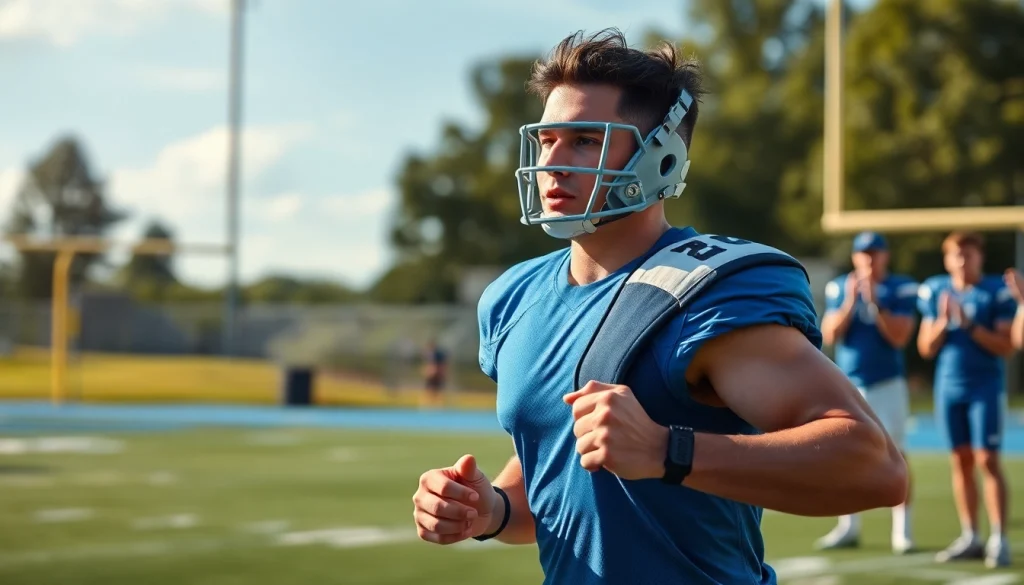Innovative Shoulder Braces for Football: Essential Gear for 2025

Understanding Shoulder Injuries in Football
Shoulder injuries are among the most prevalent issues faced by football players at all levels. Whether due to intense contact during tackles or repetitive strain from throwing, these injuries can significantly impact an athlete’s performance on the field. Understanding the types of injuries, their causes, and preventive measures can empower players to protect themselves effectively. When exploring options, shoulder braces for football provide comprehensive insights into addressing these injuries and enhancing recovery.
Common Types of Injuries and Their Causes
Football players commonly suffer from various shoulder injuries, including:
- Rotator Cuff Injuries: Often caused by the repetitive overhead motions involved in throwing, these injuries are characterized by pain and weakness.
- Shoulder Dislocations: Typically resulting from direct contact or falls, this injury can lead to instability and recurrent episodes.
- AC Joint Sprains: Common in contact sports, a sprain occurs when the ligaments connecting the collarbone to the shoulder blade are stretched or torn.
These injuries can occur due to various factors, including improper technique, lack of conditioning, or inadequate warm-up routines. Understanding the mechanics behind these injuries is essential for effective prevention and treatment.
Impact of Shoulder Injuries on Performance
Shoulder injuries can have a drastic effect on a player’s performance. Pain and reduced mobility can hinder not only throwing power but also tackling and blocking capabilities. This can lead to a decrease in overall effectiveness on the field. Furthermore, players may develop compensatory techniques that can increase the risk of injuries in other areas of the body, such as the back or knees, leading to a vicious cycle of injuries.
Preventive Measures: The Role of Shoulder Braces
One effective preventive measure is the use of shoulder braces, which offer support and stability during gameplay. They can prevent injuries by limiting excessive motion and providing compression that helps in the recovery from previous injuries. A well-fitted shoulder brace can aid in reintegrating injured athletes back into practice and competition while minimizing the risk of re-injury.
Choosing the Right Shoulder Brace for Football
Finding the proper shoulder brace for football involves considering various factors that contribute to both comfort and effectiveness. Not all braces are created equal, and the choice can significantly impact the performance and recovery of the athlete.
Features to Look for in a Shoulder Brace
When selecting a shoulder brace, consider these key features:
- Adjustability: A good brace should offer adjustable straps for a personalized fit, ensuring it stays in place during play.
- Material: Look for breathable materials that provide comfort without restricting movement. Moisture-wicking fabrics can help keep the athlete dry.
- Support Level: Different braces offer varying levels of support. Choose one that suits the specific needs of the athlete, whether for injury prevention or rehabilitation.
Top Brands and Their Offerings
Several brands specialize in high-quality shoulder braces for football, including:
- DonJoy: Known for its advanced support technology, DonJoy provides braces designed for serious athletes.
- Bauerfeind: Offers ergonomic designs that promote movement while providing essential support to the shoulder joint.
- McDavid: Renowned for its affordable options without compromising on quality and support.
Price Ranges and Budget Considerations
Shoulder braces vary widely in price, often based on the brand and technology used. Basic models can start around $20, while advanced braces with innovative technology may cost upwards of $200. It’s essential to consider both the budget and the specific needs of the athlete to make an informed choice.
Benefits of Using Shoulder Braces During Football
Incorporating shoulder braces into a football player’s regimen offers numerous benefits that extend beyond injury prevention.
Improved Stability and Protection
One of the primary advantages of using shoulder braces is the stability they provide to the joint. This stability can be crucial during high-impact scenarios often witnessed in football, enhancing the player’s confidence while tackling or being tackled. Moreover, braces protect against acute injuries by absorbing some of the impact forces.
Enhanced Performance and Endurance
With increased stability, players are likely to experience improved overall performance and endurance. A shoulder brace can help athletes maintain their active range of motion while providing the support necessary for extended play, reducing the fatigue that can lead to injuries.
Real-Life Success Stories from Athletes
Numerous athletes have successfully integrated shoulder braces into their training and gameplay. For instance, a linebacker recovering from a shoulder dislocation reported that using a brace not only provided pain relief but also allowed him to play at a level close to his pre-injury form. His confidence grew, knowing he had a protective measure in place.
Proper Usage and Care of Shoulder Braces
To maximize the benefits of shoulder braces, proper usage and care are essential. Athletes should be educated on how to fit, maintain, and recognize when it’s time to replace their braces.
How to Fit Your Shoulder Brace Correctly
Fitting a shoulder brace correctly is crucial for optimal support. Players should follow the manufacturer’s instructions, ensuring the brace is snug but not overly tight, as this might restrict blood flow. Adjust the straps to achieve a secure fit that maintains stability while allowing for natural movement.
Maintenance Tips for Longevity
To ensure your shoulder brace lasts, proper maintenance is key. Here are some tips to consider:
- Regularly wash the brace according to the care instructions to remove sweat and odors.
- Inspect the straps and materials periodically for wear and tear, replacing them if necessary.
- Store the brace in a cool, dry place away from direct sunlight to prevent degradation.
Signs That You Need a Replacement
Players should be aware of signs indicating it might be time to replace a shoulder brace, such as visible wear, loss of elasticity, or decreased effectiveness in providing support. Continuing to use a damaged brace can lead to further injuries.
Future Trends in Sports Bracing Technology
The world of sports bracing technology is continuously evolving, with innovative solutions that promise better performance and recovery.
Innovative Materials and Designs for 2025
Advancements in materials science are paving the way for lighter, more durable shoulder braces. New fabrics that enhance ventilation and flexibility are expected to dominate the market, allowing for increased comfort and reduced restriction during play.
Customization and Smart Technology in Braces
Customization is set to become a significant trend, with braces designed to fit individual athlete’s anatomy. Furthermore, the introduction of smart technology, such as sensors integrated into the brace, may provide real-time feedback on an athlete’s shoulder health and performance metrics, leading to better training and preventive strategies.
Insights from Sports Medicine Experts
Sports medicine experts emphasize the importance of continuous research into injury prevention, suggesting that technology will play an essential role in developing future bracing options. They advocate for collaboration between manufacturers, healthcare providers, and athletes to ensure that innovations meet the real needs on the field.






